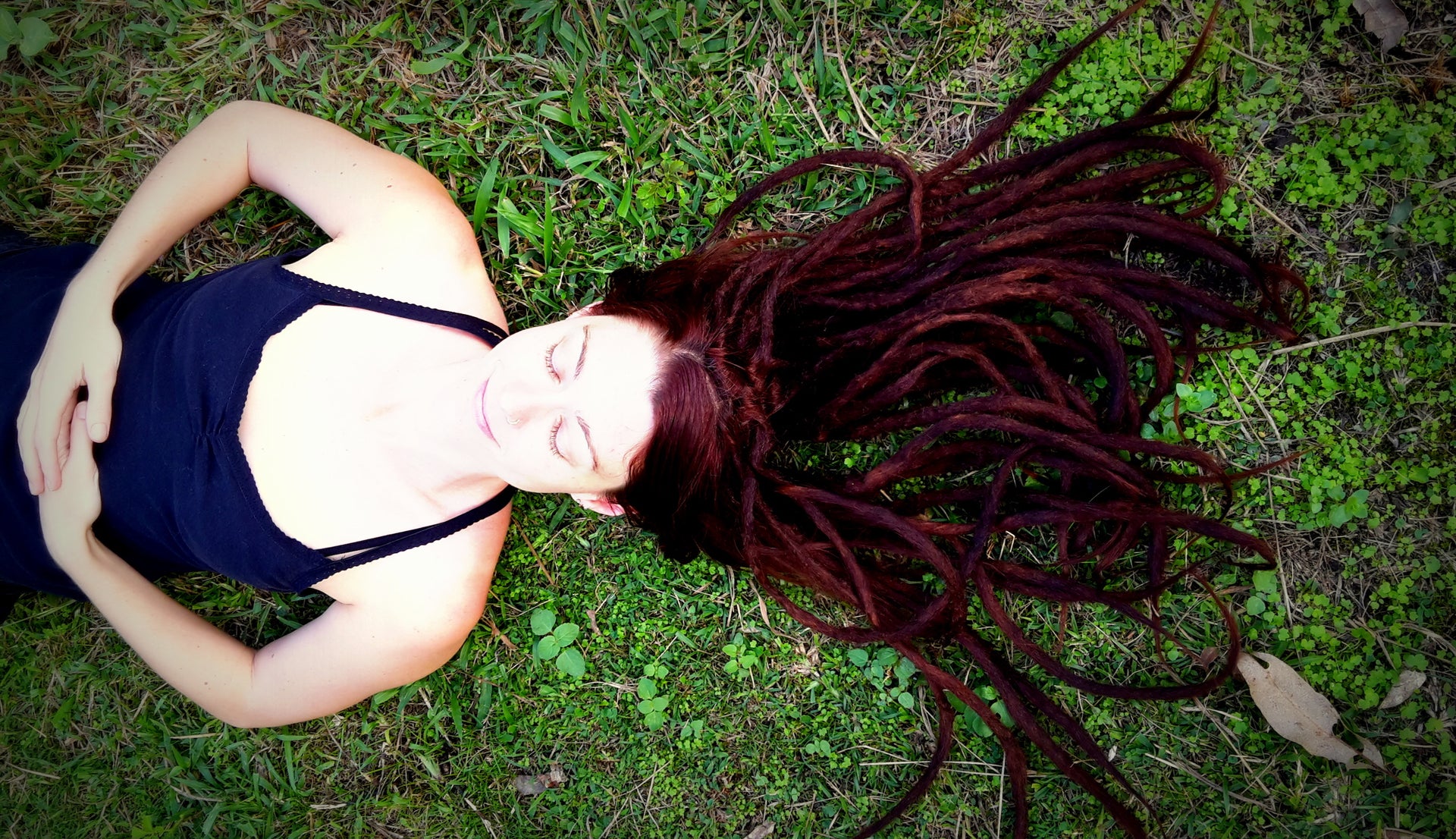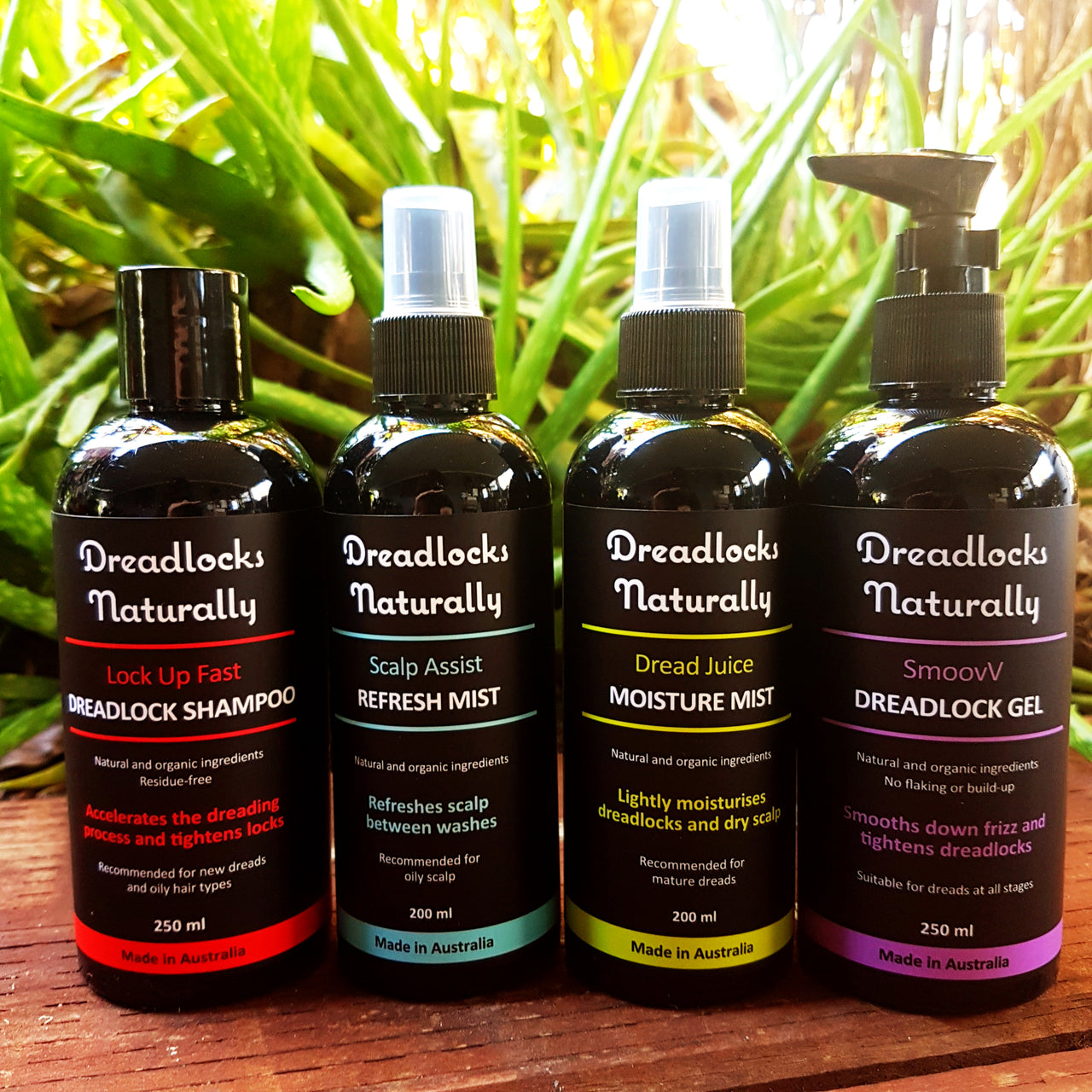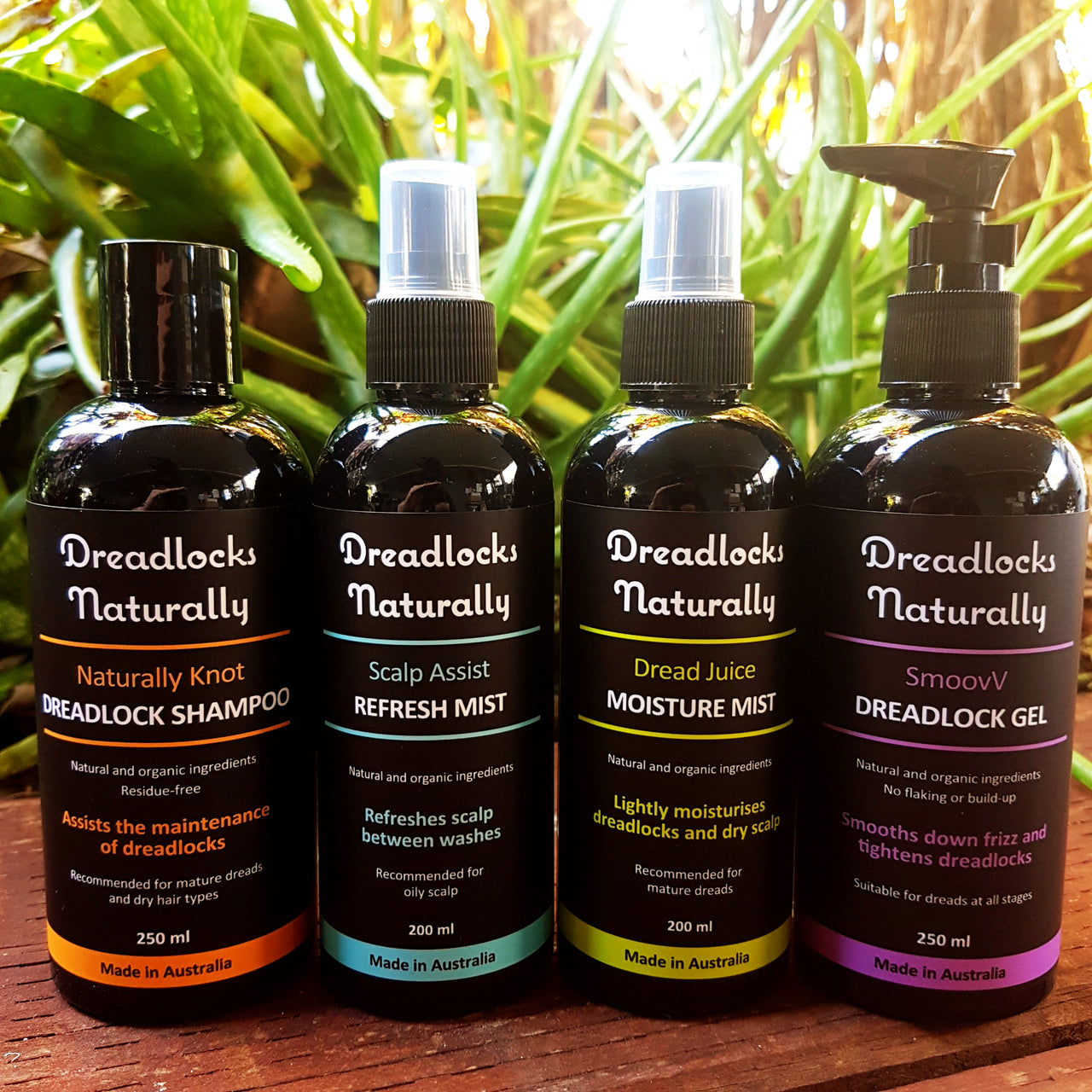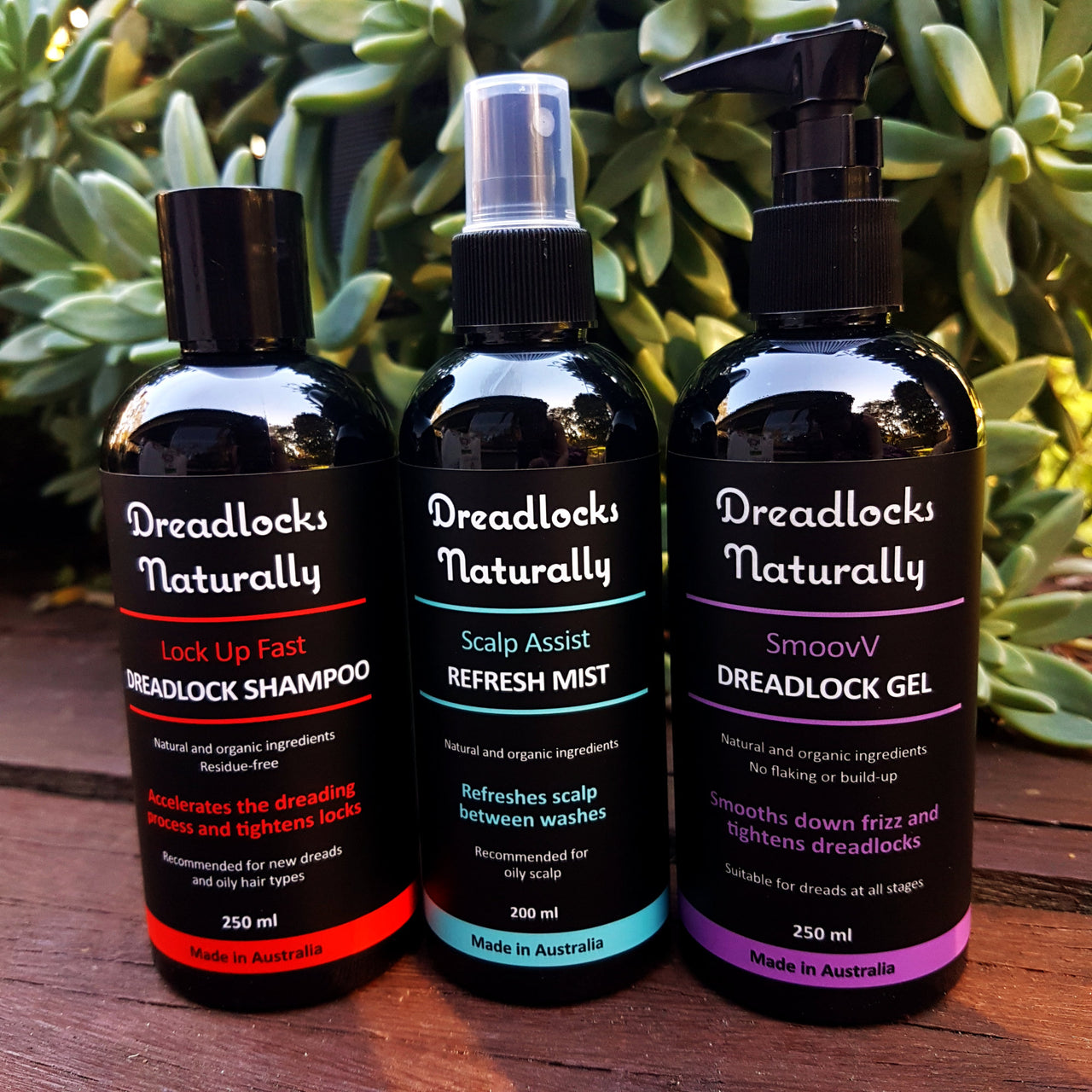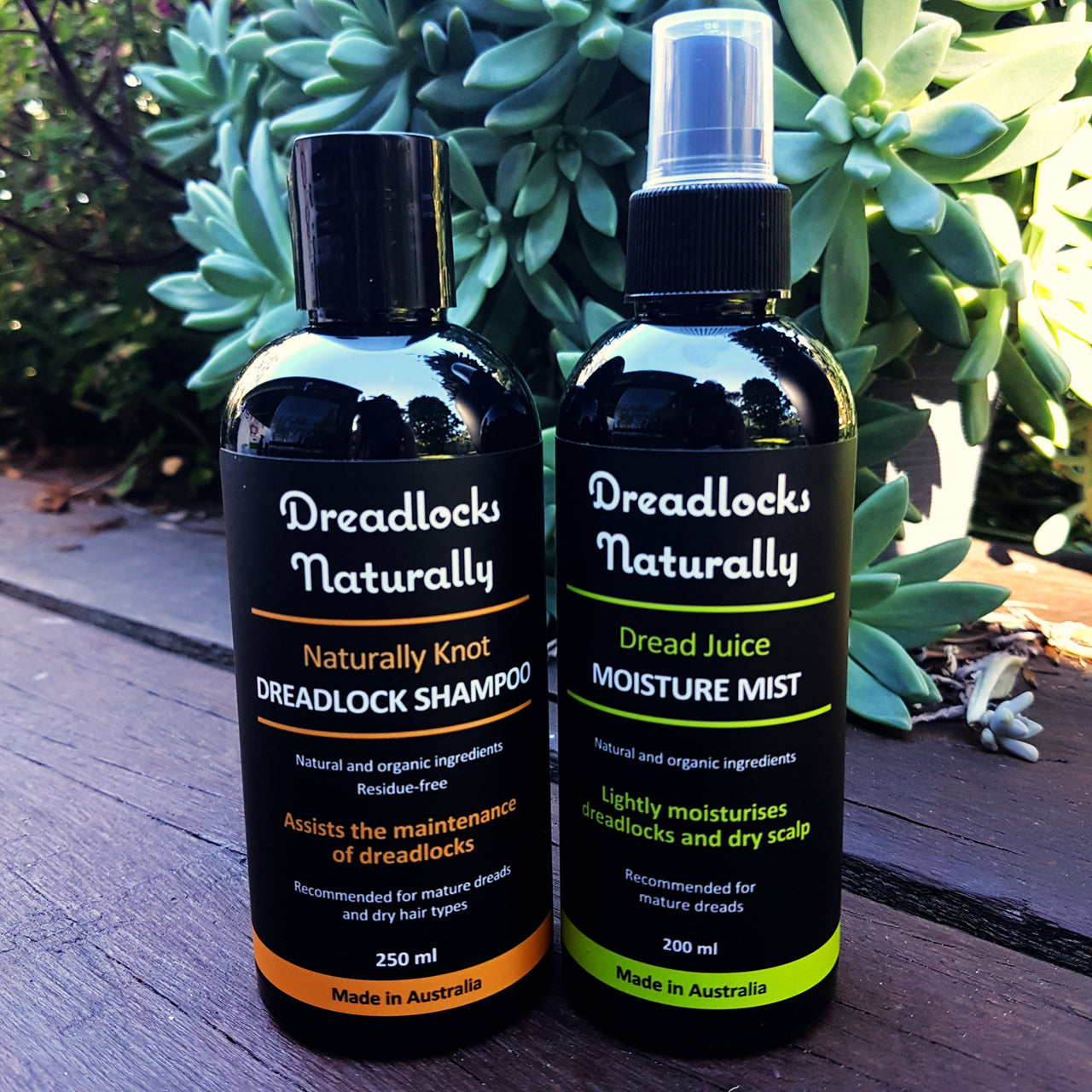Dreadlock Help
General Dreadlock Care
How often should I wash my dreadlocks?
As often as you need to! We usually recommend washing weekly or within a day or 2 of flaking or itching starting - this is a sign that you need to clean your scalp.
Also, clean hair dreads best and washing regularly with Dreadlocks Naturally shampoo's will knot up your regrowth and tighten your locks with every wash.
Drying your dreadlocks properly
It is really important to ensure that your dreadlocks get dry as fast as possibly after being wet. This is especially important for mature dreadlocks that are very dense as they can hold a lot of water and if left like that for too many hours may contribute to mould and dread rot, not great!
We recommend squeezing out as much water as possibly from your dreadlocks after they get wet. Then wrap them in a towel for about 20 minutes to absorb as much water as possible. Then get out into the sun if you can, they will dry really quickly when exposed to full sun. If this isn't possible we definitely recommend blow drying - hold the end of the hair dryer directly up against your dreadlocks - this will blow the air right into the dreadlock for the quickest dry, also hold the nozzle pointing downwards and move it down your dreadlocks from root to tip - this method is also a frizz reducer!
Which dreadlock shampoo is best for me?
We have 3 different types of shampoo formula's which have different benefits depending on your dread stage or hair type. Lock Up Fast is recommended if you have new dreads or oily/silky hair type, this formula is also incredibly good if you are wishing to start freeform dreads. Naturally Knot is recommended if you have mature dreads or a dry hair type. Colour Care is recommended if you dye your dreadlocks and want to preserve the colour or if you have damaged hair.
Do I really need to use a dreadlock specific shampoo?
If you want low maintenance dreadlocks then it's highly recommended you use a dreadlock specific shampoo as they are designed to assist the locking process.
Commercial shampoo's designed for regular hair are formulated to make the hair soft and silky, leave residues, silicone's and conditioners in your hair that are designed to keep your hair tangle free which is not so good for dreads! Using normal shampoo may make it harder for your hair to lock up and may loosen new dreadlocks and create extra fluff.
How often should I do a dreadlock detox?
We recommend doing a deep cleansing soak 2-3 times a year once your dreadlocks are mature. Mature dreadlocks can become quite dense and dirt can sometimes get trapped inside. Soaking your dreadlocks releases trapped dirt and removes any build up. If you work in an environment where you get a lot of dust in your dreadlocks then you may wish to detox your dreads more frequently.
HELP! My scalp is itchy and flaking - what should I do?
Usually washing with shampoo solves this problem. A lot of the time this is caused by not washing frequently enough, our scalp needs regular cleansing just like our body. You don't want excessive greasy flakes building up in your locs. If you don't have time to shampoo then our Scalp Assist Refresh Mist could help you out - it helps dissolve greasy build up and calm itching.
If washing doesn't solve the problem then it's possible you have a dry scalp and you could benefit from moisturising it. Check out our Dread Juice Moisture Mist or if you need something more intense you can try our Dread Nectar Oil Elixir pre-shampoo treatment.
Do I need to condition my dreadlocks?
We generally only recommend conditioning once your dreadlocks are mature, if you need to, and using dread safe products to do so. Our Dread Juice Moisture Mist and Dread Nectar Oil Elixir are 2 great products for this. Use your judgement, if your dreads start to feel dry then add in a little bit of moisture, but don't go overboard.
Our SmoovV dreadlock gel is also great for adding some light-weight moisture and is a safe way to hydrate new dreadlocks.
You can find these products in our Dreadlock Maintenance & Care collection.
Can I dye my dreadlocks?
Absolutely! You can use any type of hair dye on your dreadlocks as long as you are mindful of the process. Chemical dyes can be a little drying but this may also help your dreads to tighten while semi permanent and bright coloured veggie dyes tend to be very conditioning. We recommend seeking professional help if you want to bleach your dreadlocks as this can be quite damaging. If you have coloured locks then we recommend using our Colour Care Dreadlock Shampoo which is formulated to help retain hair colour and minimise the damage that hair dying can cause.
Synthetic dreadlocks
Dreadlocks Naturally dread care products are safe to use on synthetic locks. If you have a temporary braided in style then we recommend our Synthetic Braid In Dread Care Combo Pack.
New Dreadlocks Help
I want to start dreadlocks - how do I begin?
If you've decided to get your dread on then firstly we recommend that you stop using regular shampoo and conditioner straight away and start using Lock Up Fast dreadlock shampoo to remove any residues and put your hair in the most optimal state for dreadlocking.
If you are planning to make your own dreadlocks at home basically the process is sectioning, backcombing and then crocheting. Our Deluxe Dreadlock Starter Kit has all you need to get started! Including an instructional guide. It may help to have a friend on hand to help you do the back of your head.
You could also opt to have your dreadlocks professionally created by a loctician - there is so many out there these days, do your research about their techniques and style they offer.
I just got dreadlocks - how long do I have to wait to wash my head?
Using our Lock Up Fast dreadlock shampoo it is perfectly safe to wash your brand new dreadlocks after one week. If your scalp is really oily and itchy after only a few days you can also use our Scalp Assist Refresh Mist to get you through the week.
Some people say that you shouldn't wash new dreads for a month or so but this is usually based around the idea that they think it makes dreadlocks come undone, which could possibly happen if you use a regular commercial shampoo. But as our dreadlock shampoo's are designed to assist the locking process the opposite actually occurs. Clean hair dreads best and washing regularly with Dreadlocks Naturally shampoo's will tighten your locks with every wash.
How do I care for my new dreadlocks?
Keep them clean by washing once a week. Clean hair dreads best and leaving oils to build up in your hair may slow down the locking process. After washing it's important to separate any dreadlocks that may have joined together, feel around (especially near the roots) and snap any hairs joining 2 dreadlocks together.
Now palm roll your dreads while they are still damp, this will help to tighten the dreadlock, smooth out bumps and reduce frizz. Always leave your dreadlocks down after washing to allow them to fully dry properly. Never tie them up when wet or go to bed with wet hair. Blow dry them if you need to.
Our NEW DREADS Maintenance Pack has everything you need for looking after your lovely new dreadlocks 💜
Another handy hint - don't tie your new dreads back tightly with really thin bands as this can create weak spots in your dreadlocks. We stock a range of soft fabric elastic hair bands that are safe for dreadlocks - we especially recommend the Wide Dread Bands for new baby dreadlocks.
Do I need to use a dreadlock tightening spray?
No. We don't believe tightening spray is that effective or needed if you are using a good quality dreadlock shampoo. The number 1 tightening product is our Lock Up Fast dreadlock shampoo which tightens locks with every wash - the name says it all - it'll get your dreads locked up in no time!
Do I really need to palm roll my dreadlocks?
This is a heavily debated topic!
From personal experience palm rolling DEFINITELY makes a difference when done consistently from the start of your journey.
Palm rolling helps to keep your dreadlocks rounded, smooths out bumps that may be forming and helps to smooth down frizz. It also helps to shape and tighten your newly knotted regrowth after washing. It is best to palm roll dreads while the hair is damp straight after washing. Palm rolling when dry isn't that effective.
Some people say palm rolling doesn't do anything - but this is generally if they are doing it to try and fix solid bumps on mature dreads or they are doing it on dry dreads or not using enough pressure.
If you want your dreadlocks to be neater without doing crochet maintenance we highly recommend you palm roll after washing.
Things to avoid with new dreadlocks
When your dreadlocks are brand new and less than a few months old there is a few things to be mindful of.
Avoid tying your dreadlocks back tightly with very thin hair bands - when dreadlocks are young the knots can be easily moved around, pulling a hair tie tightly against a new dreadlock can push the knots creating a weak spot of loose hair when the hair band sits. We recommend tying your dreadlocks back loosely and with dread safe hair bands that are thicker. We have a range especially for that here at Dreadlock Shop Australia - you can check out our range of dread friendly hair ties here. We especially recommend the Wide Dread Bands for new dreads.
If you decide to decorate your new baby locs then we recommend that you move any beads around regularly. This will ensure that the beads won't get stuck in your dreads as they mature. If left in one spot for too long your dreadlock may thicken up around the bead and then prevent you from being able to remove it. It's definitely safe to decorate new locks but keep em' moving! It's probably easiest and best to remove beads before washing and then put them back in a different spot afterwards. Once your dreadlocks are mature it is safe to leave things in permanently if you desire.
Swimming - if you are a daily swimmer then we recommend easing off on this in the early stages. Submerging dreadlocks into a pool of water allows the dreadlocks to expand which can loosen them if they are freshly done and not solid yet.
Also, never tie your dreadlocks back or go to bed if they are still wet! They won't dry properly if you do this which can make them get a lil' funky. Keep your dreadlocks down to fully dry after washing or swimming.
Should I wax my dreads?
We strongly advise against the use of wax on your dreadlocks and do not sell it for that reason. Not only does wax feel greasy and sticky it actually hinders the natural locking process as it leaves a thick residue that stops your hair from moving freely and hence, will not dread easily. Wax basically just glues your hair. It also attracts dirt and fluff which will stick to your dreads and make them look dull and dirty, not a good look! It is also incredibly hard to remove wax build up. A better alternative is a water-based product such as our SmoovV Dreadlock Gel which fully absorbs into your hair, doesn't flake and leaves no sticky residue.
Frizz frizz frizz aarghhhh
Ok, so, unfortunately a bit of frizz with new dreadlocks is usually unavoidable! This is a natural thing that occurs even sometimes with mature dreads, our advice is to not get fanatical over it.
Frizz generally reduces over time as your dreadlocks mature, you don't need to crochet in every loose hair as it pops up. If you are washing using our Lock Up Fast dreadlock shampoo this will greatly help your dreadlocks to mature faster and be less frizzy. You can also use our SmoovV Dreadlock Gel to help tame any fly away frizzies.
Also check out our maintenance tip in the section below under 'Natural method to reduce dreadlock frizz' 😉
Dreadlock Maintenance Tips
How can I lock up my regrowth?
Using Dreadlocks Naturally shampoo's regularly will assist in locking up your regrowth. This is definitely the easiest method! Then palm rolling your dreadlocks after washing, especially near the base can assist in pushing all those newly formed knots into a rounded dreadlock shape.
Another natural method is root rubbing (or sometimes called clockwise rubbing) - where you hold the base of the dreadlock between your fingers and rub the root around in a clockwise direction.
You can also choose to crochet your roots as well if you like.
How to maintain your dreadlocks yourself naturally
The best thing you can do is 3 simple steps regularly - Wash, Separate, Palmroll. It's that easy!
Washing - using a dreadlock shampoo helps to knot up your regrowth and tighten your locks with every wash.
Separating - if this is done after every wash you will never have to worry about your dreadlocks forming a big congo all over your head! When done regularly there is really only a few hairs to snap at a time so it shouldn't hurt. If this step is ignored you may end up with having to endure some painful ripping apart at a later stage.
Palmrolling - this helps to keep your dreadlocks rounded and smooths out bumps and frizz. It also helps shape your newly knotted regrowth into a rounded dreadlock.
This 3 step method will certainly help you have beautiful neat hassle-free dreadlocks 💜
Natural method to reduce dreadlock frizz
Blow drying when done in a particular way can reduce the appearance of frizz. This process is greatly helped by palmrolling first after washing.
Use a standard hair dryer with no attachments, and we recommend using the medium heat and medium blow setting. Always hold the hair dryer with the nozzle pointing downwards and have the end of the nozzle directly against your dreadlocks, move the hair dryer down your dreadlocks from root to tip - this is essentially encouraging and setting any loose hairs to sit along the length of the dreadlock instead of aimlessly floating about around your head. As you slide the hair dryer down your dreadlocks you can also use your free hand to smooth down your dreadlocks as well.
Do I need to crochet my dreadlocks?
This really is personal preference depending on how neat you want your dreadlocks. It's not always necessary if you are using our Dreadlocks Shampoo's which are formulated to lock up your regrowth but some people prefer to keep them extra neat especially if they work in a professional environment.
Crocheting certainly can help to get rid of frizz and loose hair quicker, just be mindful of how you use the hook if you are doing it yourself. Loose hairs should only be pulled into the center of the dreadlock, and be sure to use a gentle motion in order not to break any hairs in the process.
Feel free to contact us with any other questions you may have 💜

